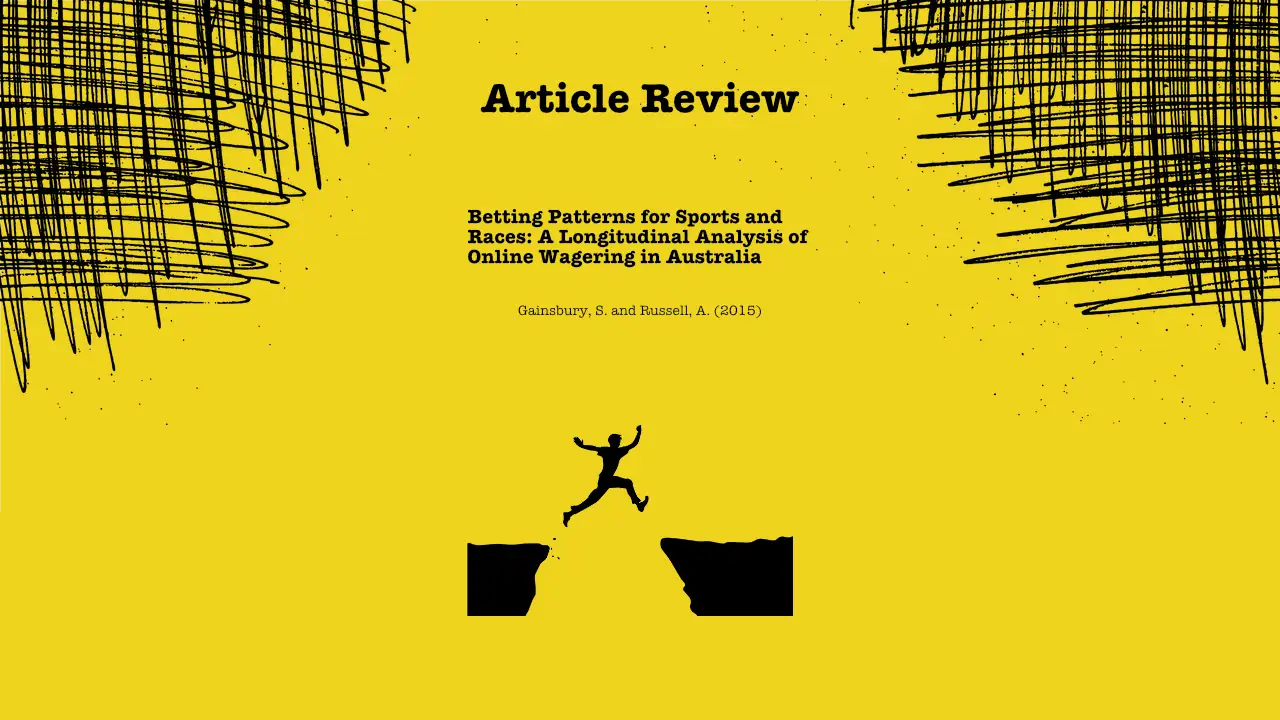Sports gambling is as much an emotional pursuit as it is a financial one. In Betting Patterns for Sports and Races: A Longitudinal Analysis of Online Wagering in Australia (Gainsbury & Russell, 2015), the authors analyze a decade’s worth of player data to uncover behavioral trends, emotional influences, and policy implications surrounding online wagering.
Their findings reveal that while most gamblers lose money in the long run, the motives and habits that drive participation go far beyond profit-seeking. Emotional attachment, convenience, and the social context of sports viewing play defining roles in shaping gambling behavior.
For regulators and policymakers, the challenge lies in maintaining a delicate balance: protecting at-risk bettors while avoiding excessive restrictions that might push users toward illegal or offshore markets.
Key Ideas
1. Emotional and irrational betting behavior
Gambling is often driven by emotions rather than logic.
- Some bettors wager on their favorite teams, even when the odds are unfavorable.
- Others overestimate their personal skill or predictive ability, exhibiting cognitive distortions such as the illusion of control.
- Emotional decision-making may produce a sense of engagement and belonging, reinforcing the gambling habit despite frequent financial losses.
These psychological factors transform gambling into a form of consumption behavior, where the act of betting itself — rather than the outcome — delivers the reward.
2. Online versus offline gambling
The rise of online gambling has significantly altered participation patterns. According to the study, the key motivations for preferring online betting include:
- Convenience and accessibility – no travel or physical effort required.
- Comfort and privacy – betting from home or mobile devices.
- Lack of crowds or social pressure – individualized experience.
- Perceived anonymity – despite the paradox of required personal registration online.
The authors note that the “easy accessibility of online wagering is reportedly the key driver in customer uptake and participation” (Gainsbury et al., 2012b).
3. Longitudinal betting outcomes
Across ten years of analysis, the average bettor was active for 5.8 years, losing 34% of total wagered amounts.
- 92% of players experienced a net loss.
- 78% of all bets resulted in losses.
- The most successful bet types were “half of the place” and “handicap” wagers.
This data illustrates that sports gambling profitability overwhelmingly favors the operator, not the consumer. For research and policy, such long-term figures reveal the economic persistence of loss patterns among habitual bettors.
4. Emotional consumption and fandom
The research supports earlier findings (Paul & Weinback, 2013) suggesting that betting and sports consumption are interconnected behaviors.
Many fans place wagers to enhance the viewing experience, even if it contradicts rational decision-making. Betting becomes a form of emotional expression and team loyalty, often opposing the bettor’s own financial interest.
This phenomenon explains why some fans consistently bet on their favorite teams, reinforcing their identity as supporters rather than investors.
5. The “novelty” effect in gambling
Beyond traditional sports betting, “novelty betting” — on events like elections or entertainment outcomes — represents a growing segment.
These markets:
- Generate curiosity and engagement.
- Introduce new bettors to gambling systems.
- Are typically more profitable for players than standard sports wagers.
The novelty effect promotes themed gambling as entertainment, expanding participation beyond traditional sports audiences.
6. Policy and regulation implications
Regulators face a dual responsibility:
- Protect vulnerable gamblers by recognizing high-risk behavioral patterns, and
- Preserve the freedom and enjoyment of recreational betting.
Overly restrictive measures may backfire, stimulating the illegal or grey gambling market, as demonstrated by the historical U.S. prohibition (amended in 2018).
Thus, targeted, evidence-based regulation remains the optimal approach — addressing harm without suppressing legitimate leisure activity.
Selected Citations
- “Easy accessibility of online wagering is reportedly the key driver in customer uptake and participation in this mode of betting.” (Gainsbury et al., 2012b)
- “Approximately half of all bets were placed for a win ... This may indicate that bettors prefer simple, uncomplicated bets.”
- “Betting trends follow popular sports spectatorship and bettors, like fans, appear to enjoy seeing the best teams and preferring games televised on major networks.” (Paul & Weinback, 2013)
- “Bettors may be influenced by emotions and preferences when placing bets, rather than probability of economic outcomes.”
Academic Reference
Gainsbury, S., & Russell, A. (2015). Betting Patterns for Sports and Races: A Longitudinal Analysis of Online Wagering in Australia. Journal of Gambling Studies, 31, 17–32.
External References
- Paul, R. J., & Weinback, A. P. (2013). Baseball: A Poor Substitute for Football: More Evidence of Sports Betting as Consumption. Journal of Sports Economics, 14, 115–132.
- Gainsbury, S., Sadeque, S., Mizerski, R., & Blaszczynski, A. (2012). Wagering in Australia: A Retrospective Behavioural Analysis of Betting Patterns Based on Player Account Data. Journal of Gambling Business and Economics, 6(2), 50–68.
